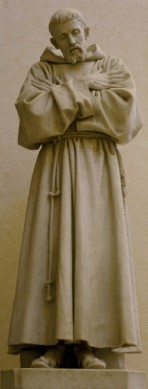 Michael at The New Liturgical Movement has pointed out that a regular reader of their blog, Todd, is looking at the question of "what is 'active participation' as used in the Vatican II document Sacrosanctum Concilium?" over at his own blog Catholic Sensibility.
Michael at The New Liturgical Movement has pointed out that a regular reader of their blog, Todd, is looking at the question of "what is 'active participation' as used in the Vatican II document Sacrosanctum Concilium?" over at his own blog Catholic Sensibility.I personally find Todd's perspectives a bit "progressive" at times, but he often does make some good points and is seeking answers. In this case he certainly makes a great point that we need to look at the actual document of Sacrosanctum Concilium in order to see what the Council Fathers intended.
I have always thought that Fr. Zuhlsdorf (link to the actual article listed below) has had the best analysis of the issue which I have seen, mainly because he does not look at Sacrosanctum Concilium as an isolated document. Rather, he has looked at it in the context of the liturgical movement in the Church which led up to the Second Vatican Council. The liturical aspect of Vatican II was not just some idea which the Council Fathers came up with out of the blue. There was an authentic liturgical movement going on in the Church, one which focused on greater use of chant (the monastery of Solesmes was probably the greatest contributer to bringing chant to the forefront). Another aspect of the liturgical renewal of the early 20th century was helping the laity to gain a better understanding of the liturgy.
Anyway, to sum up Father Z.'s conclusion, he basically says
"This is very important. Active participation is “perfect” in the form of reception of Holy Communion."
This makes much more sense in the context of the time leading up to the Second Vatican Council, especially in light of Pope Saint Pius X's allowance of daily Communion and lowering the age for first Communions.
There is also much to be said about Gregorian Chant in the Mass regarding the same liturgical movement.
Father Zuhlsdorf's entry on "active participation" is well worth the read: The True Meaning of "Active Participation"






3 comments:
Thank you Chris for leading us to Fr. Zuhlsdorf's article! What an awesome article! Our family had a wonderful discussion about this matter tonight. Fr. Zuhlsdorf makes perfect sense out of the Vatican II documents in that our receiving of the Eucharist is the "active participation" in the Most Holy Sacrifice of the Mass.
Chris, thanks for the plug and the visitations. Great blog and nice aerial shot of St Peter's above, btw.
I have less of a favorable view of Father Z's essay, which could have been improved without the "loony" adjectives and the gross misrepresentation of what progressives consider "full, conscious, and active participation."
He does make some good points, but isolating out his one notion, "the perfect form of active participation is the active receptivity of the Communicant in the state of grace at the moment of reception of the Eucharist" carries with it a danger that we've begun to see in the clamoring for the reception of Holy Communion outside of Mass.
In other words, if we're focused on an end (or a key) result, namely "getting" Communion, we overlook the context of the rituals, Scriptures, and prayers that make up the act of worship. A "perfect" form of participation, by this definition, can seem to be independent of the active ministry of a priest.
It seems strange for me, a progressive, to argue it with a conservative like Father Z on this point, but I think "ideal" full participation must include each of the Church's many liturgical ministries working together toward leading people to a full experience of worship. Including the clergy.
I would disagree with the idea of participation including the liturigcal ministries in that sense. Only until the changes of Vatican II were these ministries opened to lay people, but even now the use of the laity for these ministries is "as a last resort." If there are officially instituted lectors and acolytes (which can only be men, as opposed to readers and servers) then they are to perform these duties. Although the minor orders were supressed, the Church has still retained the proper institution of lector and acolyte (although in practice this is 99.9% of the time only given to seminarians).
It has never (even now) been the proper roll of the laity to perform these ministries in the liturgy.
Post a Comment